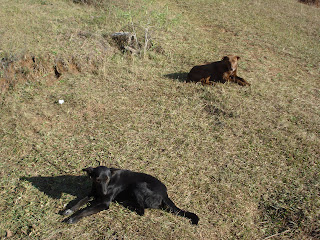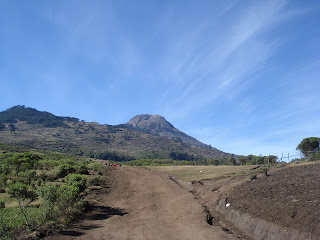During the holidays, when not a whole lot of work is being done in Guatemala, Katie and I took advantage of the downtime and took a trip to Mexico. We visited Puerto Escondido, Oaxaca and San Cristobal de Las Casas, Chiapas. We had a really good time and if you want to see more about our time there, I advise you to head over to Katie's blog at
undresongadventure.blogspot.com. She did a great job chronicling our travels and activities. I'm going to focus on the one truly important aspect of the trip...the beers.
Before going to Mexico, I have had a few Mexican beers that are available in the States: Corona, Tecate, Dos Equis and Pacifico. While they don't measure up to the fine craft brews that one can purchase or make, they are pretty solid beers. In Guatemala, the beer landscape is dominated by light and tasteless beer; namely Gallo. It is the national beer and they have a monopoly on the market here. The one island of dark deliciousness in the sea of blandness is Moza, a bock style beer that is Guatemala's one decent beer. It is hard to find however and usually a bit more expensive. With all that said, when we went to Mexico we were excited to sample their beers. Here's a few that we enjoyed.

The Mexican staple: Corona. It quenches thirst, goes down easy and when you have lime and a bit of salt....it is damn good. Here, we enjoyed a few Coronas while we were waiting for some fish we caught to be prepared.

Superior, another light Mexican beer that is pretty commonplace. Not quite as tasty as Corona, but it did the job with the street tacos that join it in this picture.

Modelo Especial. I guess that Modelo is one of the fancier beers in Mexico, as it seemed to be a bit more almost everywhere we went. At this particular restaurant we were able to find beer on tap, a rarity. Modelo Especial is okay, a step ahead of Superior but not quite as good as Corona.

Leon, one of the dark beers. While shopping in a huge grocery store in Puerto Escondido, we happened upon a six pack of this stuff, which cost 48 pesos. With roughly 12 pesos to a dollar, it was a tough deal to pass up. However, once we got to the beach and sampled the goods, we realized why it was so cheap. Not a whole lot of flavor or body, it has a dark color but drinks like a light beer.

I am not sure who makes this, but this is a specialty beer made for Noche Buena, which is also the name of the beer. Noche Buena is what Spanish speakers call Christmas Eve, which tends to be the bigger celebration rather than Christmas Day. This was a real good beer, probably the darkest one we had while in Mexico. It was real malty and was heavy enough that you could only drink a couple. It was a nice find.

Dos Equis Amber. This is a good beer, not like a true amber that one might find in Idaho, Oregon or Washington; but still a solid beer. Being able to drink it on tap definitely helped.

Negra Modelo. Another beer that we can get in the States, Negra Modelo is a tasty beer. Like Modelo Especial, it was on tap and a bit pricey, but worth the few pesos extra.

In my humble opinion, the best of the Mexican beers, Bohemia Oscura. This beer was just right, dark and malty, but still smooth enough to down a few. While we were in Puerto Escondido, this was what we looked for when we stopped in to have a beer.

Duff beer. We didn't buy it because it was expensive, but apparently someone in Mexico is a big Simpsons fan and has the means to brew this as a tribute. Unless The Simpsons took the idea from Mexico. Who knows, either way pretty funny.















































